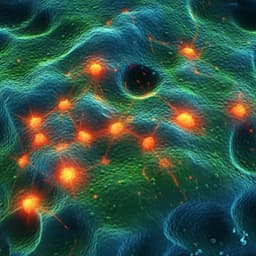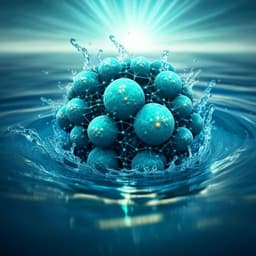
Chemistry
Highly efficient electrosynthesis of hydrogen peroxide on a superhydrophobic three-phase interface by natural air diffusion
Q. Zhang, M. Zhou, et al.
This groundbreaking research by Qizhan Zhang, Minghua Zhou, Gengbo Ren, Yawei Li, Yanchun Li, and Xuedong Du introduces a superhydrophobic natural air diffusion electrode that significantly enhances oxygen diffusion for hydrogen peroxide production. This innovation leads to rapid H2O2 synthesis with remarkable efficiency, paving the way for sustainable industrial applications.
~3 min • Beginner • English
Introduction
The study addresses the challenge of efficient, in situ electrosynthesis of H2O2 via the two-electron oxygen reduction reaction (ORR). Conventional industrial production (anthraquinone process) is energy-intensive and generates waste, while electrochemical methods suffer from low oxygen solubility, mass transfer limitations, low oxygen utilization efficiency, and high aeration energy in gas diffusion electrodes (GDEs). The research question is whether a superhydrophobic, naturally air-breathing electrode can overcome oxygen mass transfer limitations, eliminate aeration, and enhance H2O2 production efficiency and selectivity at practical current densities. The work proposes a natural air diffusion electrode (NADE) based on carbon felt (CF) with a tunable hydrophobic catalytic layer to establish a stable three-phase (gas–liquid–solid) interface and systematically investigates how hydrophobicity, pore structure, and diffusion area affect ORR kinetics, oxygen transport, and H2O2 productivity.
Literature Review
Prior work improved H2O2 electrogeneration mainly by catalyst optimization and forced aeration through GDEs. Carbonaceous catalysts (carbon black, nanotubes, graphene) are selective for the 2e− ORR, but mass transfer limits performance as potential/current increase due to low O2 solubility (~8 mg L−1). Typical GDEs require pumped O2/air and show very low oxygen utilization efficiency (OUE, often <1%), and aeration energy can dominate overall consumption, especially upon scale-up (e.g., >1000 kWh kg−1 reported for aeration in a 100 L unit). Modifications to GDE catalytic layers (e.g., quinones, azo compounds, PTFE binders, hydrophobic films like dimethyl silicone oil) can enhance hydrophobicity and selectivity but often still rely on aeration and may suffer flooding, unstable three-phase interfaces, or reduced electron transfer at high PTFE loadings. Reports of improved OUE (e.g., ~8.8%) still incur substantial aeration energy. A need remains for electrodes that maintain stable gas–liquid–solid interfaces without external aeration, enhancing O2 transport while preserving ORR activity and durability.
Methodology
Electrode design and fabrication: A natural air diffusion electrode (NADE) was fabricated using a 2.5-mm-thick carbon felt (CF) matrix as the gas diffusion substrate. CF was ultrasonically cleaned, impregnated with 2 wt% PTFE suspension (soak 10 min), dried, and calcined at 360 °C for 30 min to impart superhydrophobicity and mechanical strength. A catalytic layer comprising carbon black (CB) and PTFE binder was coated on one side of the modified CF. PTFE/CB mass ratios investigated: 0.1, 0.3, 0.6, 1.0, and 1.5; electrodes were calcined at 360 °C for 30 min. Catalyst loadings of 1–13.2 mg cm−2 were evaluated (typical: 4.4, 8.8, 13.2 mg cm−2).
Characterization: Surface morphology and porosity assessed by SEM; wettability via contact angle (CA) measurements; textural properties by N2 adsorption–desorption (BET surface area, BJH pore size distribution). Electrochemical characterization included linear sweep voltammetry (LSV), Tafel analysis (exchange current density j0, electron transfer number n from Tafel slope), and electrochemical impedance spectroscopy (EIS) to extract solution resistance (Rs), charge transfer resistance (Rct), and mass transfer resistance (Rmt). Electroactive surface area (ESA) determined from cyclic voltammetry in 1 M KCl with 10 mM K4[Fe(CN)6] using the Randles–Sevcik equation.
ORR/H2O2 electrosynthesis tests: Experiments performed in a 250-mL undivided reactor with NADE cathode (3 cm × 1.7 cm) and DSA anode (IrO2-coated, 2 cm × 4 cm) in 0.05 M Na2SO4. NADE was configured with the CF side exposed to ambient air through the reactor wall (air-breathing) and the catalytic layer in contact with electrolyte, establishing a three-phase interface. H2O2 concentration was determined by titanium(IV) oxalate UV–Vis method (400 nm). Current efficiencies (CE) calculated from Faraday’s law; energy consumption (EEC) from applied voltage, current, time, and produced H2O2; oxygen utilization efficiency (OUE) computed based on produced H2O2 and modeled diffusion parameters. Tests spanned current densities from 10 to 240 mA cm−2. Oxygen mass transfer was probed by varying the air diffusion area (0.175–2.5 cm2) and by comparing configurations: (i) NADE with one side open to atmosphere, (ii) NADE immersed and connected to air only via superhydrophobic substrate (narrow diffusion path), and (iii) diphase system relying solely on dissolved oxygen.
Comparative benchmark: A conventional GDE prepared by rolling method (with PTFE and CB) was tested under identical electrochemical conditions but supplied with air at 0.5 L min−1 (5 W pump). Performance (H2O2 rate, CE, EEC) was compared across current densities including 20 and 200 mA cm−2. A control using CF substrate without catalytic layer was also conducted.
Stability: Ten consecutive runs (20 h total) at 60 mA cm−2 assessed durability (H2O2 rate and CE decay). Electrolyte penetration (flooding) was visually assessed for different catalyst loadings and current densities during prolonged/high-current operation.
EAOP applications: Electro-Fenton (EF) and photoelectro-Fenton (PEF) tests performed for degradation of model pollutants at 100 mg L−1: 2,4-dichlorophenoxyacetic acid (2,4-D), phenol, methylene blue (MB), tetracycline (TC), and sulfamethazine (SMT). Conditions: pH 3 adjusted with H2SO4; FeSO4 0.5 mM; same reactor/electrodes; for PEF, UVC lamp at 254 nm, 5 W above reactor. Pollutant concentrations measured by HPLC/UV–Vis; TOC measured for mineralization; mineralization current efficiency (MCE) calculated.
Modeling: An oxygen diffusion coefficient model for porous diffusion layers under dry conditions was applied to estimate effective O2 diffusion coefficients, incorporating Fickian, Knudsen, and transition diffusion via an aperture-density function and porosity/tortuosity parameters. Experimental validation was done by identifying the current density at which H2O2 production transitions to O2 mass transfer limitation at fixed diffusion area (0.5 cm2).
Key Findings
- Superhydrophobicity and three-phase interface: A stable superhydrophobic catalytic interface was achieved at PTFE/CB = 0.6 with CA ≈ 141°, remaining stable over time and after 20 h electrolysis at 60 mA cm−2. Lower PTFE (0.1–0.2) resulted in hydrophilic or unstable interfaces susceptible to flooding.
- Porosity and transport: Increasing PTFE decreased BET surface area (171.3 to 43.9 m2 g−1) and micropores but increased meso-/macroporosity, enhancing O2 transport. The CF substrate had high porosity (>90%) and macropores (~50 µm spacing), enabling air diffusion.
- Oxygen diffusion coefficients: Effective O2 diffusion coefficient of modified CF diffusion layer was 1.15 × 10−1 cm2 s−1 (model), close to O2 in air (2 × 10−1 cm2 s−1) and about 5.7× higher than a traditional GDE microporous layer (2.02 × 10−2 cm2 s−1).
- ORR kinetics and impedance: Higher PTFE reduced current response and exchange current density (j0) due to fewer active sites and hindered electron transfer; however, hydrophobic interfaces (PTFE/CB ≥ 0.6) drastically lowered mass transfer resistance (Rmt: 3.73 Ω at 0.6 vs 25.52 Ω at 0.1) while moderate PTFE maintained reasonable charge transfer.
- Optimal composition and loading: PTFE/CB = 0.6 maximized H2O2 production and CE. At 60 mA cm−2: H2O2 = 30.94 mg h−1 cm−2, CE = 81.3% (1 h), with electron transfer number n ≈ 2.07. Increasing catalyst loading from 4.4 to 13.2 mg cm−2 increased ESA (to 5.62 cm2) and H2O2 rate (to 30.93 mg h−1 cm−2) but excessive thickness can limit internal O2 diffusion; too low loading risks electrolyte penetration at long time/high current.
- Air-breathing vs dissolved oxygen: NADE performance was insensitive to dissolved oxygen concentration in electrolyte, indicating gas-phase diffusion dominates. Configurations with restricted diffusion path or relying solely on dissolved oxygen showed much lower H2O2 accumulation.
- Diffusion area dependence: At small diffusion area (0.175 cm2), ORR is O2 mass-transfer limited even at high current; expanding area to 2.5 cm2 removes O2 limitation, shifting control to electron transfer at given currents.
- High-current operation: H2O2 production increased linearly with current density up to 240 mA cm−2 (R2 = 0.995), reaching 101.67 mg h−1 cm−2 with CE ≈ 66.8% and EEC ≈ 19.4 kWh kgH2O2−1. At 20 and 60 mA cm−2, EECs were ~4.55 and 6.92 kWh kg−1 for rates 10.97 and 30.93 mg h−1 cm−2, respectively. At fixed diffusion area 0.5 cm2, mass transfer limitation onset near 60 mA cm−2 was used to validate De in the range 0.75 × 10−1 to 2 × 10−1 cm2 s−1.
- Comparison to conventional GDE: Without external pumps, NADE outperformed a normal GDE that required 0.5 L min−1 air (5 W). At 20 mA cm−2: 10.97 vs 9.01 mg h−1 cm−2 (+21.7%); at 200 mA cm−2: 83.37 vs 51.73 mg h−1 cm−2 (+61.2%). CE at 200 mA cm−2: 65.72% (NADE) vs 40.78% (GDE). NADE also shows markedly higher OUE (44.5–64.9%) and lower EEC than literature values, while eliminating aeration energy.
- Stability: Over 10 consecutive cycles (20 h) at 60 mA cm−2, H2O2 rate and CE decreased by at most ~5%, indicating stable operation and sustained superhydrophobicity.
- EAOP performance: In EF, complete removal of pollutants (2,4-D, phenol, MB, TC, SMT) achieved within 60–90 min, with TOC removals at 2 h of 51.1% (2,4-D), 55.1% (phenol), 62.0% (MB), 57.5% (TC), and 39.5% (SMT); MCE: 35.3%, 79.7%, 45.7%, 49.0%, and 28.4%, respectively. Energy consumption for 2,4-D mineralization significantly lower than literature (66.4 vs 420 kWh kgTOC−1). PEF further enhanced performance (e.g., TOC removals up to ~89% for phenol in 2 h) without additional aeration energy.
Discussion
The NADE design directly addresses the core bottleneck of ORR-based H2O2 electrosynthesis: oxygen mass transfer. By using a highly porous, superhydrophobic CF diffusion layer and a catalytic layer with tuned hydrophobicity (PTFE/CB ≈ 0.6), the electrode maintains a stable gas–liquid–solid interface that supplies oxygen from ambient air without pumping, decoupling performance from dissolved oxygen in the electrolyte. This eliminates flooding, reduces mass transfer resistance, and sustains high H2O2 production even at high current densities where conventional GDEs become oxygen-limited and inefficient. The combined structural (meso-/macropores) and interfacial (superhydrophobicity) optimization balances oxygen transport with electron/ion transfer, maximizing CE and OUE while minimizing energy consumption. Demonstrated durability and superior benchmark performance underscore scalability potential and relevance for decentralized, cost-effective EAOPs, where avoiding aeration yields substantial energy savings.
Conclusion
The study introduces a superhydrophobic natural air diffusion electrode that enables efficient, aeration-free H2O2 electrosynthesis. Key contributions include: (1) establishing a stable three-phase interface with high effective O2 diffusion (≈1.15 × 10−1 cm2 s−1) and minimized mass transfer limitations; (2) achieving record-level H2O2 productivities with high CE and OUE across a wide current density range, including 101.67 mg h−1 cm−2 at 240 mA cm−2; (3) demonstrating superior performance to conventional, aerated GDEs and strong stability over extended operation; and (4) validating applicability in EF/PEF wastewater treatment with high pollutant removal and reduced energy consumption. Future work could optimize catalyst architectures for enhanced active sites without sacrificing hydrophobicity, explore long-term operation under varied wastewater matrices, integrate reactor designs for scale-up, and further quantify aeration-free lifecycle energy and cost benefits.
Limitations
- Current efficiency decreases over time due to parasitic decomposition of H2O2 (e.g., disproportionation), more pronounced at higher current densities.
- Excessive PTFE content lowers active site density and increases charge transfer resistance, reducing ORR kinetics; insufficient PTFE leads to unstable hydrophobic interfaces and potential flooding.
- Very low catalyst loading can allow electrolyte penetration during long-term or high-current operation; too high loading can limit internal oxygen diffusion due to increased thickness.
- At small air diffusion areas, performance becomes oxygen mass transfer-limited, indicating reactor design must ensure sufficient diffusion area for high-current operation.
- While durability over 20 h was shown, longer-term stability and performance under varying real wastewater conditions were not reported.
Related Publications
Explore these studies to deepen your understanding of the subject.







